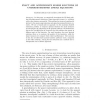Free Online Productivity Tools
i2Speak
i2Symbol
i2OCR
iTex2Img
iWeb2Print
iWeb2Shot
i2Type
iPdf2Split
iPdf2Merge
i2Bopomofo
i2Arabic
i2Style
i2Image
i2PDF
iLatex2Rtf
Sci2ools
SIAMSC
2008
2008
Exact and Approximate Sparse Solutions of Underdetermined Linear Equations
Abstract. In this paper, we empirically investigate the NP-hard problem of finding sparsest solutions to linear equation systems, i.e., solutions with as few nonzeros as possible. This problem has received considerable interest in the sparse approximation and signal processing literature, recently. We use a branch-and-cut approach via the maximum feasible subsystem problem to compute optimal solutions for small instances and investigate the uniqueness of the optimal solutions. We furthermore discuss five (modifications of) heuristics for this problem that appear in different parts of the literature. For small instances, the exact optimal solutions allow us to evaluate the quality of the heuristics, while for larger instances we compare their relative performance. One outcome is that the so-called basis pursuit heuristic performs worse, compared to the other methods. Among the best heuristics are a method due to Mangasarian and a bilinear approach.
Related Content
| Added | 14 Dec 2010 |
| Updated | 14 Dec 2010 |
| Type | Journal |
| Year | 2008 |
| Where | SIAMSC |
| Authors | Sadegh Jokar, Marc E. Pfetsch |
Comments (0)

